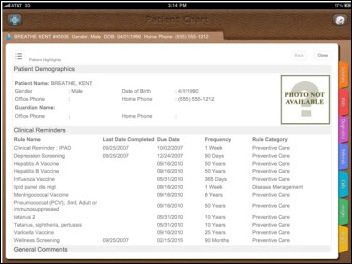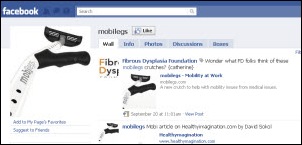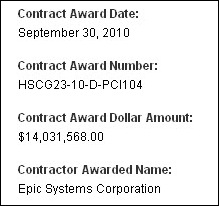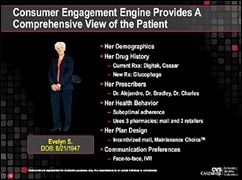Merry Christmas and a Happy New Year to the HIStalk crowd. I wish you the joys of the season!
News 10/6/10
From StateHIECoordinator: “Re: Iowa. The state has issued a Notice of Intent to Award to ACS for the Iowa Statewide Health Information Exchange.” SHIEC sent over the award letter that went out to the eight bidders. It includes technical scoring and prices, but I’m not sure if I should run that since it may not be public information. The selection went down to frontrunners ACS and Medicity in the “best and final offer” round, with ACS winning on price.
From Maladroit: “Re: book. You mentioned a book on healthcare IT and the future sometime in the last ear. I don’t remember much about it except it seemed like a great book to help me understand a CIO’s perspective as he/she thinks about maturing their tech org. Do you remember the book?” Hmm. I’ve mentioned a few books, but I don’t remember this one particular. It might have been Ed Marx, too, since he’s well read. Readers, if you know the book or have others to recommend on that topic, let me know and I’ll run a list.
From Wax On: “Re: medical transcription acquisitions. The big buzz among the MT community at the recent AHIMA convention in Orlando was about Nuance acquiring both OSi and Encompass Medical Transcription. And in another deal, Keystrokes acquired Chartnet.” I’m appreciating the irony that the hottest technologies in healthcare IT appear to involve transcription. Voice and paper are hard to kill for good reason.
From Ex-Employee: “Re: CareTech Web Division. All sales staff let go last week. Management plans to eliminate the Web division and focus solely on outsourcing.” Inga contacted the company for a response:
On the heels of significant growth in its Web products and services segment, CareTech made the decision to adjust its go-to market approach for the Web business with an emphasis on balancing its growth with providing the best delivery service. The decision involved a shift in resources, including a reduction in the area of Sales, and an increase in technical resources for the Web Development and Account Management areas. The company remains committed to its Web products and services business, and is especially looking forward to the opportunity to see current customers and meet new ones at the 14th Annual Healthcare Internet Conference where CareTech will have an exhibit and speaking engagement.
From Long Time Reader, First Time Writer: “Re: MU. Several CIOs I work with are gnashing their teeth because their vendors are telling them they’ll only apply to have their latest software version certified. Clients on the now-current version will have to pay the vendor for an upgrade and service fee to get on a ‘certified EHR’. Some have said they are being quoted months to get the upgrade because customers that signed lucrative contracts with the vendor’s service arm are moving to the head of the line. Love the blog BTW.” I guess I’m seeing it through the vendor’s eyes – ONC made them jump through hoops to get their products certified and to get them implemented by a firm date, so somebody has to pay and not every customer can be the first to go live. I’d blame the government for trying to tie something as complex as EHR adoption to something as desperately made up on the fly as economic stimulus. But if you have a particularly egregious vendor example, tell me since I’m sure some are milking it hard.
Ingham Regional Medical Center (MI) helped start and fund the Capital Area RHIO, but won’t participate in it. The hospital and its parent company will instead join Michigan Health Connect, explaining that, “A lot of the larger systems decided to go that route so they wouldn’t have to participate in different RHIOs and repeat the investment over and over again.”
Inga trumped Weird News Andy on this article, although she kept it at arms’ length when she sent it my way, saying it’s “a bit icky for my taste.” It’s a little raw for me too, but if you’re fascinated to know the “Strangest Foreign Bodies Removed From Patients”, many of which seem to involve unusual sexual practices, feel free to check it out. I did, but I think I regret it now.
ONCHIT puts up a Certified Health IT Product List page. It doesn’t include the CCHIT-certified products yet.
The Government of Queensland will implement (warning: PDF) the MetaVision Clinical Information System from iMDsoft in the ICUs of 14 hospitals.
Blessing Health System (IL) will implement Patient Condition Tracker from Rothman Healthcare Corporation within Allscripts Sunrise Clinical Manager. Their nursing school will also participate in research studies involving the system, which turns 26 measurements and observations from the EMR into a single number called The Rothman Index that allows early detection of patients going bad. I’ll have an interview with the co-founder up shortly.
Jack Kowitt, SVP/CIO of Parkland Health & Hospital System, e-mailed to say he was happy that I was puzzled by an ARRA comment attributed to him by the Dallas business paper since he was misquoted. The article said the hospital “won’t seek federal stimulus funds because its electronic records upgrades started before the stimulus bill was passed,” which I thought was odd since HITECH payments aren’t linked to spending. I indicated probable reporter error, which was the case according to Jack: “The question was whether we were using any stimulus funds to implement the EMR. The response was, since we have already implemented, we would not. It wasn’t about MU money, which we are aggressively pursuing.”
It appears that CCHIT’s initial press release that listed certified products was incorrect. ChartAccess from Prognosis Health Information Systems was listed under EHR Modules in the hospital domain, but the current product list shows it as a certified complete EHR in the hospital domain, the only one other than EpicCare.
I got an e-mail blast from a seemingly desperate free HIT magazine today, urging me to post five comments to their online articles to be eligible for a giveaway (so much for highfalutin’ journalistic integrity – what’s The New York Times paying for sending in letters to the editor these days?) Since it mentioned their expert bloggers, I thought I’d check out the competition for the first time. All the blog entries I saw except one seemed to come from other sites – they’re just reprinting them on their own site like they were written for the dead tree people. Maybe I’m an amateur purist, but both the comment bribe and the reposted blogs strike me the wrong way.
Inga contacted the folks at Infogard to get pricing information for their ONC-ATCB certification services. Drummond and CCHIT are pretty transparent about what they charge and were very nice to give Inga the information so she could put a comparison together for readers. Infogard sent her a curt reply: “Unfortunately, we will not be able to provide our price list.” We’ll make sure to help keep their secrets when their press releases come out by not mentioning them.
A Forbes blog riffs on a New York Times article about EMR vendor ClearPractice, which I didn’t realize was run by big-time VC guy John Doerr (Google, Amazon) and his brother. They also oversee a Medicare Advantage insurance plan. The Forbes writer isn’t impressed with ClearPractice or its iPad version called Nimble, although he’s focusing on the business success and not the innovation or potential:
While electronic medical records are a promising tool, the piece lacks context. For a company like Dr. Doerr’s to have been around for a decade and only have 500 doctors using the software basically means it’s failed. Check out this list of EMR vendors by market share based on physician usage. In a rapidly consolidating market there are at least 10 and probably 50 different vendors with more than 500 licenses. The idea that the Apple iPad will somehow, with an assist from stimulus funds, revive the fortunes on an individual EMR company is optimistic to say the least … The other thing that struck me is that the piece made no mention of the history of hubris when Silicon Valley tries to cure health care’s ills. Remember when Netscape founder Jim Clark devised Healtheon on a piece of paper? Or AOL founder Steve Case’s mostly expired Revolution Health?
Meditech got specific about its expansion plans Monday, announcing its intent to purchase 135 acres in a Freetown, MA business park and to build a 180,000 square foot office building for 800 new employees. A local politician estimates the company’s investment there at up to $100 million.
The University of Louisville School of Nursing gets a $792K HHS grant to develop nursing informatics education. They’ll buy simulation lab equipment that includes a patient simulator, iPads, and EHR simulators.
Interesting: a company uses Salesforce.com to deliver and analyze patient EEGs, looking for similarities in a database of known EEG irregularities to suggest psychotropic medications to doctors treating mental illness.
MedAssets is holding its Business & Technology Forum this week in Orlando.
Weird News Andy’s contribution this time around: “1/3 off healthcare ‘reform’ … I wish.” A report (warning: PDF) finds that HHS has already missed a third of the deadlines mandated by the Patient Protection and Affordable Care Act, with another 29 coming due in the next three months.
And speaking of government efficiency, health insurance premiums for 8 million federal workers will go up 7.2% in 2011, which the government spins by saying that’s less than increases in the private sector because of savvy negotiating.
A company brings social networking to crutches, allowing Facebook friends of the injured to create custom “skins” for their crutches. The company will offer advertising materials in the ED and expects to co-brand with healthcare systems.
The Institute for Healthcare Improvement releases a white paper to help hospitals manage serious clinical adverse events.
An interesting analysis: hospitals are buying up primary care practices to prepare themselves to become Accountable Care Organizations, which could be the end of the line for small, independent practices. Hospitals are looking at increasing PCP salaries like a Wall Street analyst looks at price-to-earnings ratios, knowing that internists and family practitioners generate hospital revenues at nine times their average salaries, while expensive specialists generate a multiple of only five times their salary. For industry noobs, it’s time for hospitals to get taken to those 1990s cleaners all over again, because:
- Docs sell out precisely because they don’t want to work as hard for their new hospital employer as they did for themselves (duh).
- Hospitals are notoriously bureaucratic and inefficient managers, making them particularly unsuited for running a low-overhead medical practice in every way from EMRs to personnel policies to regulatory compliance.
- Private practice docs hate and distrust everything about hospitals except the money they have and don’t usually change their opinions or behaviors just because they sell them their practices.
- Doctors resent taking orders and being told how to practice medicine, especially from suit-wearing hospital MBA-types who fancy themselves business experts despite always having worked for a paycheck instead of themselves, making it likely all these deals will fall apart in 4-5 years like they did last time around, with the docs scrambling to start up new practices without the benefit of a location, an EMR, or patients that they sold away to the local hospital in a frenzy of co-opetition.
- Patients aren’t much more enthused about hospitals than doctors are, so they aren’t exactly thrilled to see the big sign go up over their friendly little doctor’s office knowing it’s the same folks with ED waits, bad cafeteria food, and terrible parking.
HERtalk by Inga
From RDU Dude: “Word on the street is that Vern Davenport has left Allscripts.” Portly Gentleman sent us a note on October 1 suggesting Allscripts would soon announce some executive changes. He named names (Vern’s being one of two), but we didn’t run them since it didn’t seem right until it actually happened. The company confirms that the former Misys president and Allscripts exec has indeed moved on.
Over 50 practices in Tenet Healthcare markets select MED3OOO’s InteGreat PM and EHR as part of a Tenet/MED3OOO community-based EHR partnership.
Hearst Corporation appoints Gregory H. Dorn MD, MPH president of drug database provider First DataBank. He most recently served as EVP at another Hearst company, Zynx Health, and replaces Donald M. Nielsen, MD, who becomes chairman of the First DataBank Advisory Board.
Omnicell acquires Pandora Data Systems, a provider of analytical software for medication management. The Pandora solution is used by several HIT companies, including CareFusion, McKesson, Cerner, and will continue to be operate as a stand-alone product. Omnicell’s comparable product is about twice as expensive, so there goes your cheaper alternative, most likely.
Epic wins a five-year, $14 million EHR contract from the US Coast Guard, replacing a version of the Department of Defense system. That could be a notable Epic foothold in government down the road.
Penn State Hershey claims its use of CareAware technology has contributed to a 90% decrease in manual charting during surgical procedures. Providers now average one minute of charting during surgery, compared to 10 minutes before the CareAware implementation.
I love and appreciate all our sponsors, but this is funny. I received a note from one today (someone in accounting who has probably never heard of HIStalk) asking us to re-issue an invoice. The reason: they had asked to pay their sponsorship over several invoices, so dividing the total led to a per-invoice amount of xxx.1666 (infinite decimal). We invoiced xxx.17. They’re asking to correct the remaining invoices to xxx.16 so that the yearly total hits the amount exactly instead of being four cents over. Who else wonders how that accounting department handles client issues?
The Institute for Health Technology Transformation publishes a new report that examines the current EHR landscape. I can’t say I gleaned much new information, but was struck by the authors’ comment that the EHR “landscape” is still in its “infancy.” Given that I was selling EHRs (or EMRs as we called them in the old days) years ago, I’m thinking there must be some inverse relationship between EHR-years and dog-years.
North Kansas City Hospital deploys Cerner’s P2Sentinel auditing solution to address the hospital’s Meaningful Use Stage 1 access requirement.
Miami Children’s Hospital will spend $67 million to implement Cerner Millennium. The hospital will also extend a 50% discount to community physicians who wish to implement PowerWorks EHR in their offices. The hospital expects the government to provide $7-$8 million in stimulus funds once Millennium is fully operational.
Here is some not-so-pleasant news: at the current rate, 2010 could be one of the worst years ever recorded for mass hospital layoffs. Blame the increased demand for charity cases, the decline in reimbursements, and a reduction in elective procedures. As of August, 8,233 employees lost jobs in 102 separate layoffs, according to the Bureau of Labor Statistics. At the current rate, 12,349 jobs would be cut by December 31st, compared to 11,757 last year.
Six Texas pharmacies file a lawsuit alleging CVS Caremark of violating patient privacy laws and unfairly competing with its rivals. The complaint highlights Caremark’s plans to establish a data warehouse that includes the names, demographics, and drug histories of patients, plus Caremark’s Rx Review program that is designed to use patient data for direct marketing to patients and physicians.
Sponsor Updates:
- Allscripts introduces Mobile Homecare, a smart phone application for physical therapists, nurse assistants, and other clinicians caring for patients in their homes.
- API Healthcare signs up Halton Healthcare Services as its first Canadian client.
- Quest Diagnostic partners with HP to offer a preconfigured solution that includes Quest’s Care360 EHR and HP hardware, services, and financing.
- Wahiawa General becomes the first facility in Hawaii to implement Voalte’s iPhone solution.
- Detroit Medical Center selects the iDoc document imaging system from CareTech Solutions for its eight facilities.
- The Nashville Chamber of Commerce names Informatics Corporation of America to its Future 50 Award list for the third consecutive year. The award is presented to the 50 fastest growing companies in Tennessee.
- Catholic Health Initiatives expands its partnership with Allscripts to include Allscripts EHR and PM for all of its 1,200 employed physicians and 7,000 affiliated physicians. CHI is also adding Sunrise EPSi Performance Management solution for its 73 hospitals and will develop its own HIE with the Allscripts Community Exchange solution.
- PatientKeeper deploys its new physician documentation product, PatientKeeper NoteWriter, to Mercy Medical Center (IA) and Alegent Health (NE).













RE: vendors are telling them they’ll only apply to have their latest software version certified….
I’m kind of with you on this one, brother. Most of the vendors have shifted gears in order to make sure their products have the features and functionality to allow a user to demostrate MU. Some undoubtedly had to do more development than others. If they don’t do that, (a) they won’t get certified, (b) no one will buy it. Why would they certify a version that won’t meet MU? That’s the whole idea, isn’t it?
Here’s an idea…can HISTalk figure out a way to compare vendors across the board to see how much, on average, it’s costing the average user, to upgrade to the MU version?
Also, are there any vendors whose EHR didn’t need ANY upgrades to allow a physician to demonstrate MU?
About IHTT: “The mission of the Institute for Health Technology Transformation: to drive improvement and the meaningful use of technology throughout the continuum of care through education and collaboration among multiple stakeholders.” Is this the cousin or niece of HIMSS?
The White Paper fails to mention safety. It assumes that these products are safe. The 4 families who lost babies to death and injury at a totally wired hospital in Seattle would beg to differ with the IHT2 report. They would say that the technology is experimental and shoudl be scrutinized for safety.
It is not a surprise to me that safety and usability is ignored in the industry sponsored reports on their products and sales.
Suzy, don’t you feel even a little obligated to provide some evidence that the Seattle deaths were cause by HIT problems?
Re: hospitals buying up PCPs: Thank God. I lived in a place dominated by small practices, and a family member practices there. It’s a model of inefficiency: patients go to specialists to manage basic problems instead of GPs, records are disparate and shared only cautiously, patient meds are adjusted by different MDs and aren’t considered holistically, and patients doctor-shop. If I had a serious medical need, the only person who was going to manage it was me. There would be no partnership there with my primary and any needed specialists.
Then I moved to a city and got a health plan where all of my physicians worked for my HMO. Scary, right? On the contrary, it was a great experience as a patient to have doctors that all talked to each other. When I had to go under the knife, my surgeon knew my PCP and had access to his notes in the EMR. The physician therapist was down the hall from the surgeon. And when I returned for my check-up, my PCP knew everything that had happened and had the documentation. It was a wonderfully integrated health system with the right tools.
Now, hospitals buying PCPs does not a health system make. But it’s a step in the right direction. Speaking as a patient: please, don’t give me a 1-doc shop. I can’t promise to be a 1-problem patient.
Agreeing with Irony here Suzy. Here are some of the highlights from one of the Seattle news sites:
In the first case on Sept. 16, a nurse gave an 8 month old baby 10 times the prescribed dose of calcium chloride.
The next day, a nurse gave a newborn patient medication without approval from a licensed provider. That baby died, but a cause of death has not been determined.
And eight days after that, a 23-year-old man with breathing problems was incorrectly given epinephrine. The man went into cardiac arrest.
Whether or not Seattle Children’s is fully electronic (CPOE, Electronic Clin Doc, BCMC, etc. (Mr. H., maybe an interview with their CIO would help this), examples two and three from above is not HIT-related and the first example does not give us enough information as to how the nurse handled the order/administered the drug. So unless you’re intimately involved in a given hospital’s workflow, stay away from such hysterics.
Longtime reader, first time commenter. The discussion is provocative. The deaths of babies is an adverse outcome in a hospital that has implemented EMR, CPOE, and other digital technology to manage the care of patients. To exclude these deaths as not associated with the hospital’s systems of care is fallacious, at best. To do so is like saying the equipment works perfectly but more patients are dying while in that hospital. Outcomes count and dead babies in an experimental system of care is a slight problem.
To exclude these deaths as not associated with the hospital’s systems of care is fallacious, at best.
So, if a nurse ignores the EMR system and kills a patient, we should still blame the EMR system?
Back away from the irony Says:
So, if a nurse ignores the EMR system and kills a patient, we should still blame the EMR system?
Illogical.
The Straw Man fallacy is committed when a person simply ignores a person’s actual position and substitutes a distorted, exaggerated or misrepresented version of that position. This sort of “reasoning” has the following pattern:
1. Person A has position X.
2. Person B presents position Y (which is a distorted version of X).
3. Person B attacks position Y.
4. Therefore X is false/incorrect/flawed.
This sort of “reasoning” is fallacious because attacking a distorted version of a position simply does not constitute an attack on the position itself. One might as well expect an attack on a poor drawing of a person to hurt the person.
My analogy isn’t illogical at all. The situation I described appears to be exactly what that poster is saying we should do.
“nurse ignores the EMR system and kills a patient”
Why would a nurse ignore EMR devices? Doctors ignore their nuisance jabberwock wll of the time.
Let’s see and count the reasons. Usually because it is an impediment to efficient bedside care, poorly usable, causes mistakes, and distracts from the care of the patient in the bed.
That the EMR device may have been ignored does not mean it did not have an adverse impact on care. The EMR device is not an innocent bystander with all users being guilty of user error.
Let’s see and count the reasons. Usually because it is an impediment to efficient bedside care, poorly usable, causes mistakes, and distracts from the care of the patient in the bed.
More likely the patient is dead because their doctor or nurse was incompetent.
I’m beginning to see why you like making claims without any supporting evidence. It makes it virtually impossible to lose an argument.
That the EMR device may have been ignored does not mean it did not have an adverse impact on care. The EMR device is not an innocent bystander with all users being guilty of user error.
No one has said that the EMR is always an innocent bystander. What people like you are saying, without a shred of evidence to support your claims, is that the EMR is always guilty.